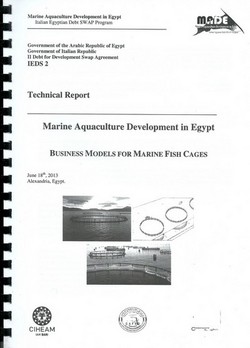
Marine Aquaculture Development in Egypt
Italian Egyptian Debt SWAP Program
Technical Report
Marine Aquaculture Development in Egypt
Business Models for Marine Fish Cages
June18.2013, Alexandria, Egypt.
Introduction
This document intends to provide to the potential investors with a clear estimation of the economical feasibility of the installation and management of three different types of marine fish cage farms.
At the same time, this document is structured as a tool that could be easily adapted and adopted by potential investors for elaborating specific Business Plans to be presented to commercial and financial partners and to elaborate a clear articulation of their investment project.
For a more exhaustive comprehension, this document should be read in strict connections with the other Documents realized by the MADE project, notably the Road Map for the development of Marine aquaculture, that provides a clear vision of the state, constraints and perspectives of the marine aquaculture in the country, and the Best Management Practices for Cage aquaculture, where a potential investor could find a set of practices for optimizing the technical, and thus economical, performance of cage farms.
According to the aim of the MADE project we will focalize on the two main marine species of interest of the project: seabass and gilthead seabream. At the same time most of the element introduced and a relevant part of the costs are easily adaptable to the aquaculture of other marine species that could be of interest for the Country (such as Meagers of Flathead Mullets).
The development of the aquaculture of seabass and seabream that is at the basis of the vision of the MADE Project is the key Business Idea that will be articulated in this document. At the same time the MADE Report Main and new candidate species factsheets provides a clear vision of the potential new species for aquaculture.
A short market analysis for the product selected will be reported and directly sewed to the perspective of the enterprise investing in the sector. Despite the Model are specifically aimed at the primary production, the market analysis will take into consideration the Value chain aspects in order to have a wider vision of the potentialities. More specifically we will analyze three investment models, differing in size and typology of the technology adopted. The choice on the more suitable size and typology of the business model strongly depend on the characteristic of the investor such as SMEs, large investors or cooperatives, but at the same time depend on the location where the cages are to be installed. The three models are the follows:
<!--[if !supportLists]--> 1. Off-shore cage aquaculture. Production capacity: 200 Tons
<!--Off-shore cage aquaculture. Production capacity: 400 Tons
<!--[if !supportLists]--> 3. Small size cage aquaculture in lagoons or lakes. Production capacity: 7 Tons
For each of the 3 models we will describe the typology, the technical aspects that are more relevant for the economic sustainability of the investment, the choice of the location, the size options and the input options as well as some organizational aspects.
Having defined those elements it will be possible to go in-depth into the main aim of this document that is to provide information on the actual economic and financial feasibility and sustainability of those models, by elaborating the relative basic performance indictors. For simplifying the estimation in our models we have simulated similar parameter for Seabass and Seabream, in fact while the growth of the latter is slightly faster, the FCR remain similar.
Having obtained the performance data for these basic models, we will pass to consider some variable, such as the rearing of Meagre or the estimate of the additional production deriving from shorter fattening period.
The element of this document should be then adapted by each investor in order to be transferred into an actual Business Plan.
Contents
<!--Introduction
<!--The Business Idea
<!--The Market Analysis
<!--The Models and their Economic Performance
<!--Conclusions



ساحة النقاش